SRAM HYDRAULIC DISC BRAKE GREASE
(formerly known as SRAM DOT Grease)
Hydraulic Brake Grease, previously known as DOT Grease, is a specialized grease made by SRAM that works with both Mineral Oil and DOT braking systems. This unique product is specifically designed to facilitate the installation of SRAM brakes and is essential for proper brake setup. In this article, we'll delve into the advantages of using SRAM Hydraulic Brake Grease and why it's crucial to have it in your toolbox.

So what is SRAM hydraulic disc brake grease?
SRAM hydraulic disc brake grease, formerly known as DOT Grease, is a specially formulated lubricating grease that plays a vital role in the installation of SRAM Hydraulic Disc Brakes. It is important to note that despite its previous name, the grease does not contain any DOT fluid. What it does contain, however, are additives that ensure its stability when in contact with DOT fluid and SRAM approved Maxima Mineral Oil. Therefore, there is no risk of any excess swelling, shrinking or damage to the brake line or seals.
Safety and protection
When handling SRAM Hydraulic Brake Grease, it is essential to take the necessary precautions to protect yourself. This includes wearing protective eyewear, nitrile-based gloves, and workshop-level protective clothing. Hydraulic Brake Grease should be handled with care to avoid any contact with skin or eyes, as it can cause irritation. By taking these precautions, you can ensure your safety while working with this product.
What are the exact ingredients?
Well, that is a little trade secret, but I can tell you that using SRAM's Hydraulic Brake Grease is the best option for your brakes.
The formula for Hydraulic Brake Grease has remained consistent since it was branded under AVID or PitStop, so you can trust that it has a proven track record. The product will still have that distinctive orange color, and unlike DOT fluid, it does not degrade over time, ensuring reliable brake performance.
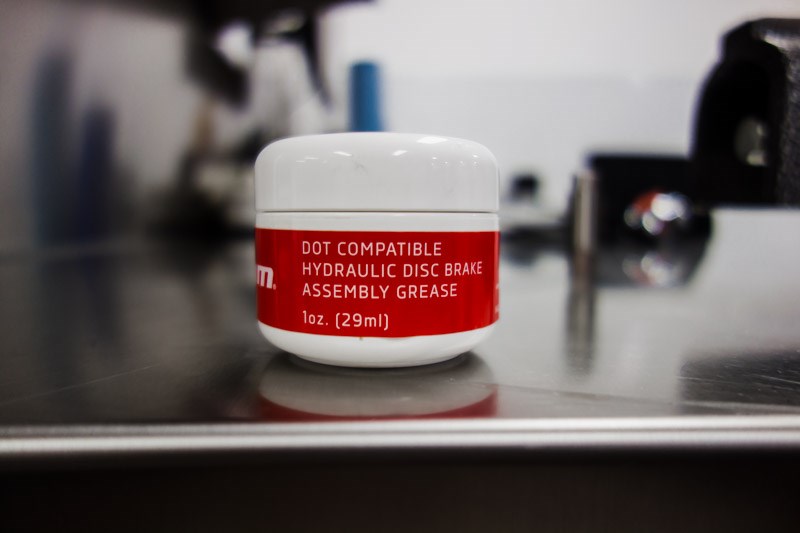
SRAM Hydraulic Brake Grease
Why do we use Hydraulic Brake Grease?
Hydraulic Brake Grease, is a crucial component in the installation and maintenance of SRAM hydraulic disc brakes. This proprietary grease is specifically designed to lubricate brake seals in the levers, protect brake lines during barb installation, and provide the necessary lubrication for compression fittings and brake olives. The use of this grease is critical in ensuring correct brake installation, as failure to use it correctly can pose a significant risk of injury or even death.
'Why can't we use just any grease?'
Now, this is where it gets a bit more detailed - we will keep this as simple as possible as this could go on for pages, but specific brake fluids dictate what rubber seal compounds can be used in a braking system. When installed and serviced correctly, these rubbers are very robust. The servicing and cleaning steps are imperative to do correctly to maintain the health of these specific rubbers and allow for proper brake function. Using grease (or fluid) that is not correct for those seals will result in a potential failure of your brakes. This happens through an interaction between the two materials where the seals can swell or shrink depending on the grease or fluid used.
SRAM Hydraulic Brake Grease has been tested and approved for use with all of our brake systems - mineral or DOT fluid. Our DOT fluid brakes use an EPDM elastomer, and our Mineral Oil brakes use Nitrile-based rubbers to seal our braking system.
All systems have a designed amount of shrink or swell per the manufacturer's specification. If a seal is to swell past the manufactures specification through an intersection via a non-approved grease or fluid, this can result in the hydraulic disc brake locking up or causing a slow lever movement. Again, the use of a non-approved grease or fluid can also cause shrinking; shrinking past manufacturers' specifications can cause fluid loss and system failure as the system may not be able to reach the required pressure on a lever pull.

Where do we use Hydraulic Brake Grease?
Hydraulic Brake Grease is required for key areas of disc brake installation and service. To start with we will show you where we use this grease and why it is so important. Using DOT in the wrong places on our brakes can also cause issues too.
Barb Installation
SRAM has used threaded barbs for over six years now. These threaded barbs offer industry-leading ease of correct fitment and longevity of sealing. When SRAM barbs are installed into the inner lining of the hydraulic brake hose, we are cutting a thread into the line itself. When threads are generally being cut, a form of lubrication is required to allow for a smooth cut. In this instance, we want a smooth cut from the barb into the inner lining of the hose.
Why is this important? In this step, we are cutting a thread into our hydraulic brake hose. Following the correct steps here is important to perform this thread cutting properly and allow for correct sealing between the hose/barb interface. If the installation is done incorrectly and without the correct SRAM Hydraulic Brake Grease, then there is a chance that fluid can bypass the inconsistent threads. This would result in a loss of pressure on the brakes, allowing them to fail.
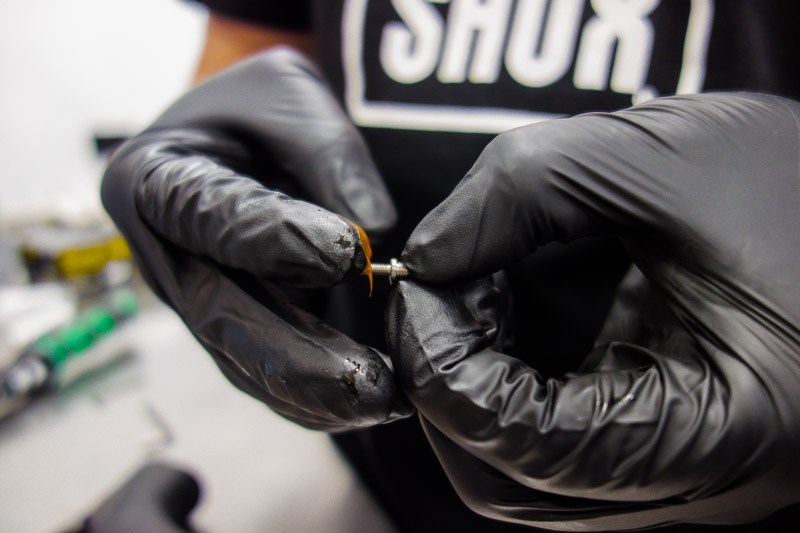
SRAM Hydraulic Brake Grease is applied to the barb threads
Brake Olives & Hydraulic Brake Grease
Brake hose Olives thread (reverse thread) onto the hydraulic hose barb and sit between the compression nut as the lever hose interface. Their role in the brake is to compress and expand in the lever body via pressure from the compression nut. As the compression nut is tightened to 8nm the olive is flattened in the lever and seals off the system, allowing pressure to build with the brake fluid with no fluid escaping from the system.
Why is this important? The use of SRAM Hydraulic Brake Grease on the olive is critical for two reasons. Firstly when the compression nut is tightened, the olive will tighten up slightly onto the brake hose. We want this olive and barb to move slightly and not bind up in one area of the lever body. If this were to bind, there would be an area for the fluid to escape from the lever, causing a loss of pressure in the system.
Secondly, the grease on the olive assists in limiting the twisting of the hydraulic brake hose. Leaving a kink-free and free-flowing hydraulic brake hose.
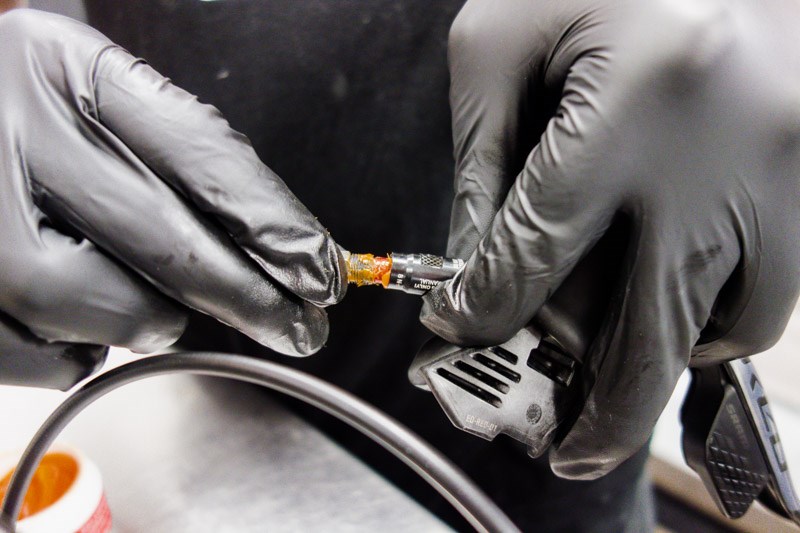
Compression nut
Once the barb and olive are installed into a brake system, the next part of the installation is sealing the system to create a seal for the fluid. This seal is what the entire brake system is based around to create pressure from the lever piston, which will move the caliper pistons.
The compression nut will physically crush and conform the olive to the brake lever to create this seal. Unlike other threaded interfaces, you want this system to deform. Typically, when you feel a bolt start to get easier to tighten, it means something bad has happened, but in this case, you actually need to tighten the nut past that point so it can create a good seal. The perfect seal of the system is reached by using a brand new olive and torquing via a crow's foot 8mm flared nut and reaching 8nm unless otherwise indicated by the manufactures specification. This step is critical to brake function, and SRAM Hydraulic Brake Grease needs to be used for this step to be done properly. The grease on these threads does a few jobs:
1) Any bolt or threads that call out grease or loc-tite will do so to give the right amount of slip to get an accurate torque reading. SRAM compression nuts require 8nm of Torque to compress the olive to conform to the lever body. SRAM Hydraulic Brake Grease i critical within this step to get an accurate torque on the compression nut.
2) The compression nut itself is steel; the strength of steel is required as this is a hollow nut used for high torque. The steel needs to be protected via the SRAM Hydraulic Breake Grease so the threads do not become seized or filled with corrosion. SRAM Hydraulic Brake Grease maintains the threads' health and assists your future self (or future mechanics) when taking this apart.
3) Ever had a bolt rattled loose before? Well, this happens to threads not having complete contact with one another; these small gaps under vibration from, say, riding offroad can cause lines to become loose. Filling these voids with grease or where applicable will assist in those threads staying at their desired torque.
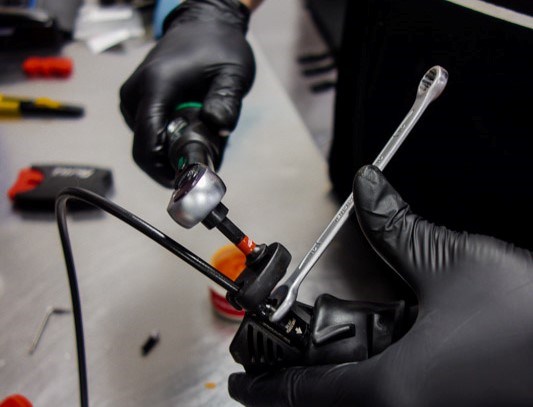
SRAM Hydraulic Brake Grease is crucial for the correct torque reading of 8nm
Lever Rebuilds
SRAM Hydraulic Brake Grease is used throughout this when rebuilding or servicing the internals of the SRAM brake levers. Please view the video below for our Guide lever revamp to see where this grease is utilized.
Where shouldn't SRAM Hydraulic Brake Grease be used?
Food, in your eyes - there is a huge list of places that Hydraulic Brake Grease shouldn't be used, but in the context to your Hydraulic Disc Brakes there are a few key areas where this shouldn't be used (and we see it used there a bit).
SRAM Hydraulic Brake Grease should not be applied to caliper pistons or caliper piston seals
Why is this? The application of SRAM Hydraulic Brake Grease on top caliper pistons can cause two issues. Firstly it can cause a slipping of the caliper pistons, which results in intermittent rubbing of the pad on rotors. The second is less than-ideal piston movement - this comes from the caliper design, where a gland is used to allow for piston roll forward and back. If this gland is blocked by debris mixing with the SRAM Hydraulic Brake Grease, it will restrict movement and again cause issues with rubbing.
Caliper mounting bolts or washer
Although SRAM Hydraulic Brake Grease will not damage paint like a DOT fluid, SRAM brake mounting bolts use Medium Loc-tite as their form of lubrication for correct torque readings and to maintain bolt tension.
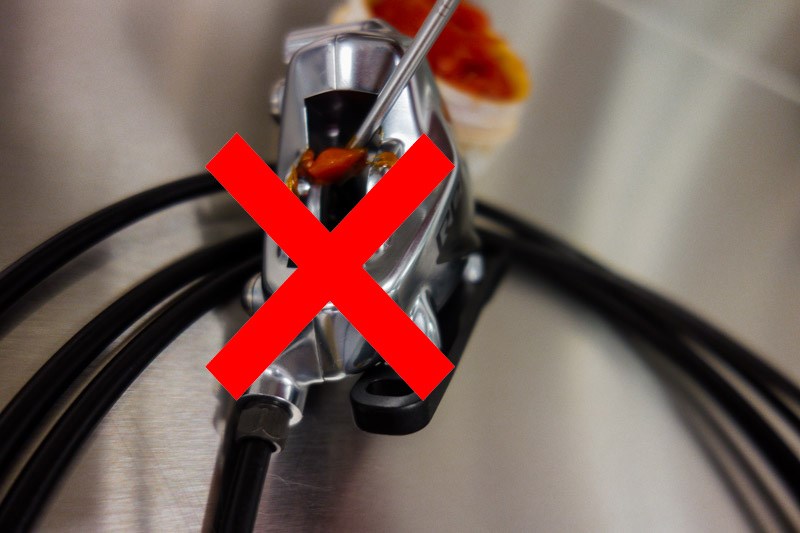
So how can I order it?
Our broad dealer network & online partners will be able to help. The part number below and the description will help you order.
Part number: 11.5315.045.000
Description: GREASE SRAM DOT ASSEMBLY GREASE 1OZ - RECOMMENDED FOR LEVERPISTONS, HOSE COMPRESSION NUTS, THREADED BARBS & OLIVE